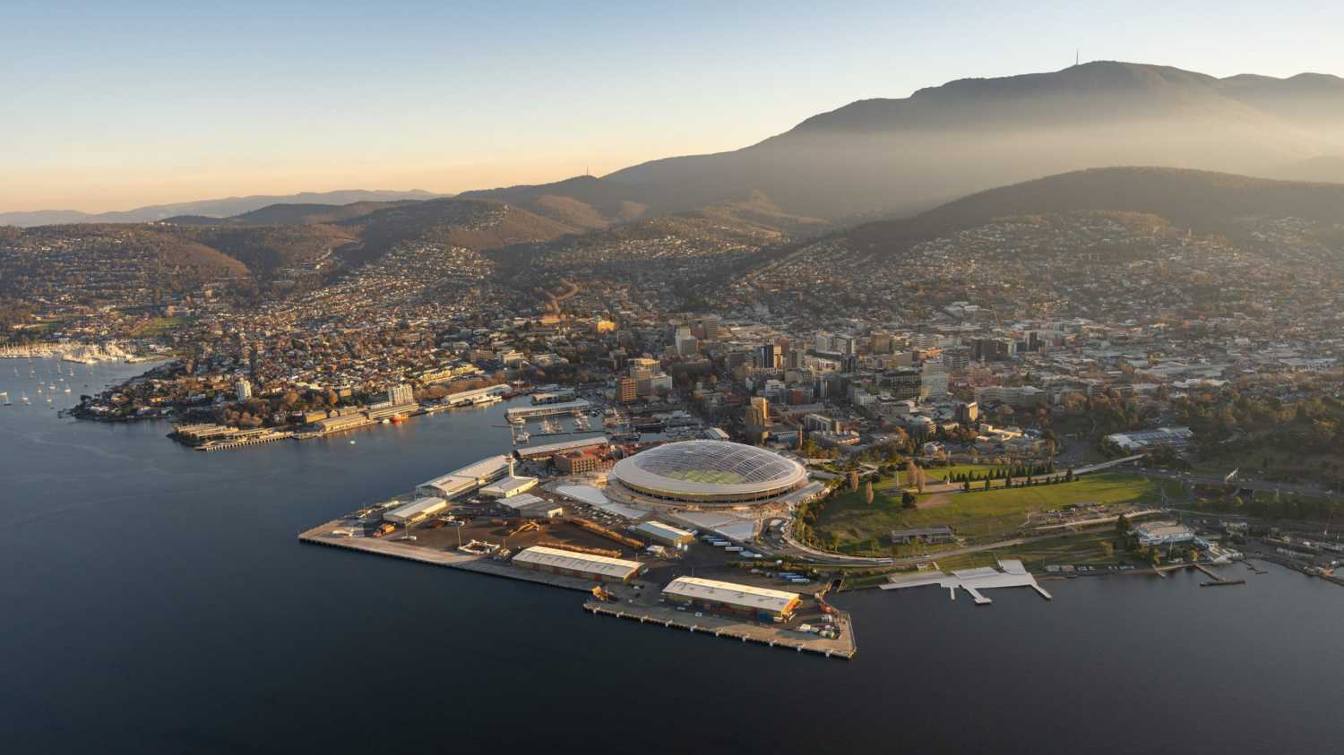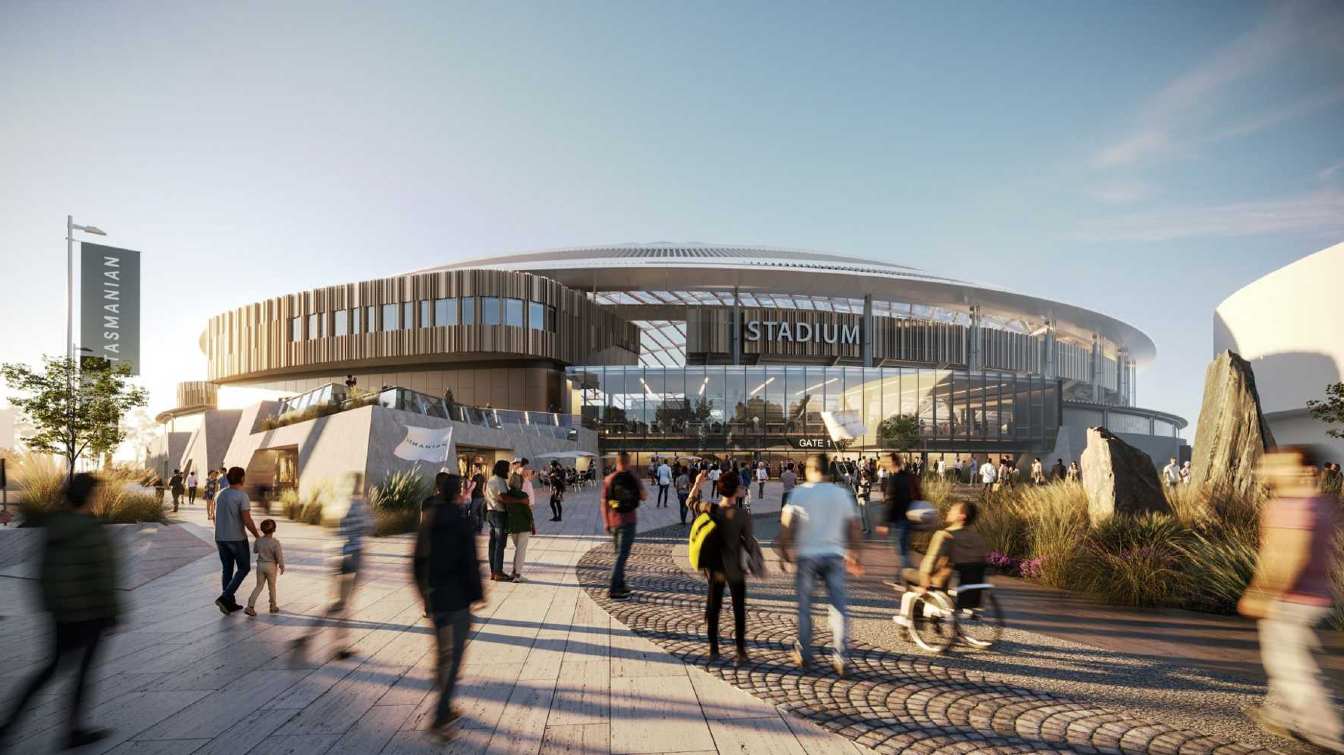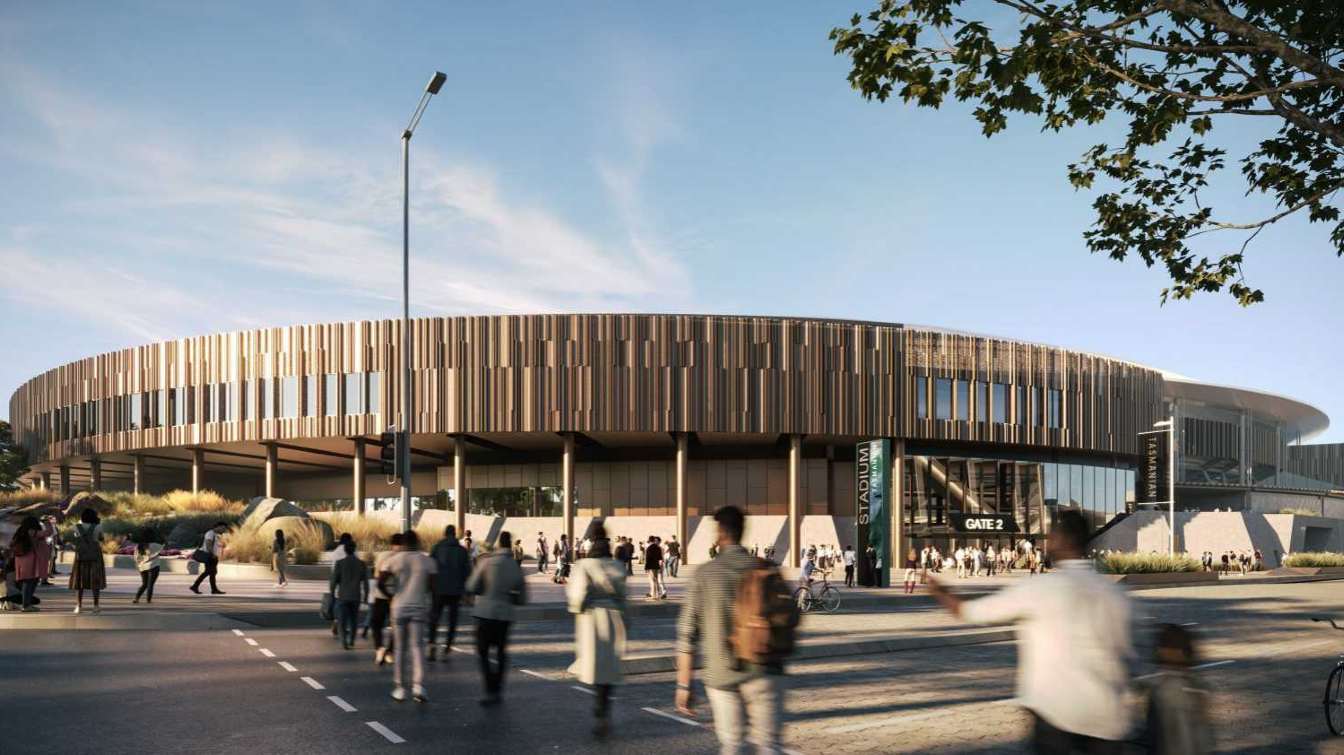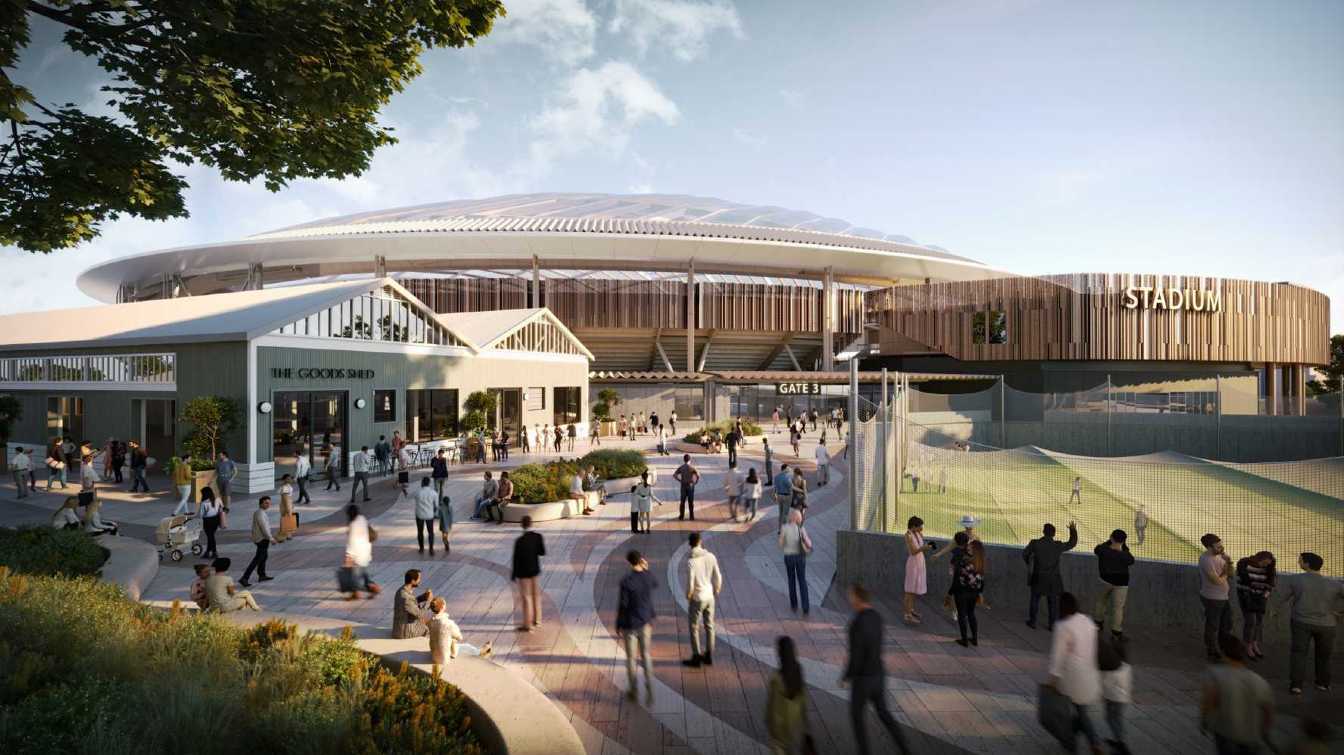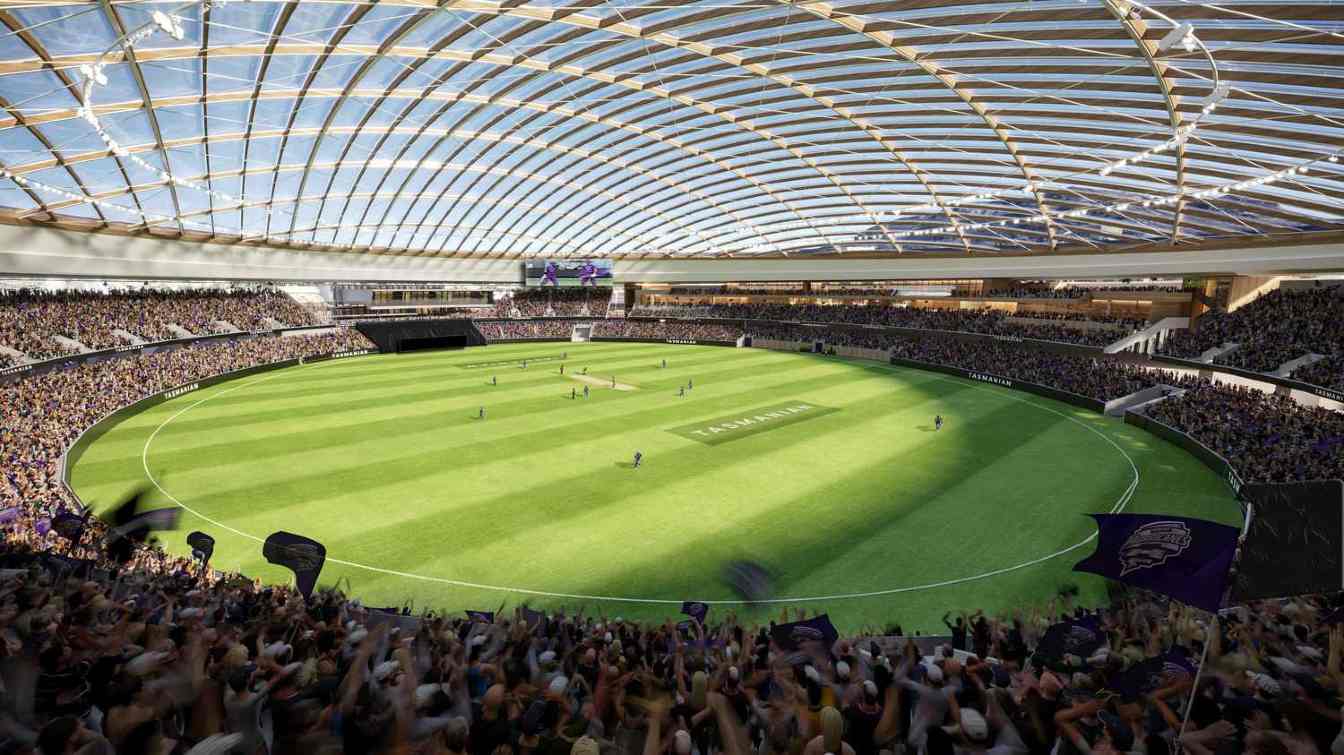Australia: Macquarie Point under fire. Tasmania fights for billion-dollar stadium project
source: StadiumDB.com; author: Jakub Ducki
 The plan to build a new stadium in Hobart is at the centre of public debate in Australia. The proposed multi-purpose venue is being described both as an opportunity for regional development and a financial risk with serious social and spatial consequences.
The plan to build a new stadium in Hobart is at the centre of public debate in Australia. The proposed multi-purpose venue is being described both as an opportunity for regional development and a financial risk with serious social and spatial consequences.
Advertisement
Stadium as a condition for Tasmania’s entry into AFL
The construction of Macquarie Point Stadium is not a random investment – it is a requirement imposed by the leadership of the Australian Football League (AFL) as a condition for admitting Tasmania to the highest level of competition. The new team, Tasmania Football Club, known as the Devils,
is set to make its AFL debut in the 2028 season, and later also join the AFL Women’s League. The conditions for participation were clearly defined earlier: Tasmania must have a modern stadium that meets national competition and commercial standards.
Until the construction of the new venue is completed, the team is expected to play its temporary
home games at existing stadiums in the state: Bellerive Oval in Hobart, which has around 20,000 seats, and York Park in Launceston, with a capacity of 21,000.
The stadium project was prepared by the well-known Australian architectural firm COX Architecture, which has a wide portfolio of sports and infrastructure projects across the country. According to the proposal, Macquarie Point Stadium is planned as an enclosed venue with a capacity of 23,000 spectators. Construction could begin in 2026 and be completed three years later, in 2029.
Serious concerns in Planning Commission report
The first major setback for the project came with the final report of the Tasmanian Planning Commission (TPC), which assessed the proposal in a highly critical manner. In its official statement, the commission described the stadium as a monolithic blot
on the Macquarie Point landscape, concluding that the investment would have an excessively intrusive impact on Hobart’s cultural and historical character. According to the TPC, the benefits of building the stadium do not outweigh its potential social and environmental costs.
The report stated that the stadium would significantly affect the panorama of Sullivans Cove, the historic setting of Hobart and the symbolic space surrounding the Cenotaph, Australia’s oldest war memorial. The document warned that a 54-metre structure would disrupt the monument’s visibility and diminish its meaning in the public space. The commission also noted that the project threatens the integrity of nearby heritage-listed structures, such as the Royal Engineers Building and properties along Hunter Street. As summarised in the report, the panel does not consider that the stadium building will be iconic, as claimed by the [AFL].
Cultural and heritage institutions raise objections
Opposition to the project also came from cultural and heritage institutions. The Tasmanian Symphony Orchestra (TSO) was particularly firm in its criticism. Its headquarters are located just 170 metres from the proposed construction site. The orchestra commissioned two independent acoustic reports, both warning of serious risks of sound leakage and vibration. The findings indicated that without advanced sound insulation, concerts, rehearsals and sound recordings could be permanently disrupted by stadium activity.
Criticism also came from the Tasmanian RSL, a veterans' organisation. Its concerns focused primarily on how the stadium would affect the visibility and symbolism of the Cenotaph, which has held national significance in Australia’s remembrance culture for almost a century. The TPC supported these concerns, concluding that the impact of the stadium on the memorial would be irreversible and unacceptable.
Tasmanian Government responds: priority investment and strategic project
The position of the Tasmanian Government differs from that of the planning authority and critics of the project. Premier Jeremy Rockliff defends the stadium, considering it a strategic investment for the future of the state. As he stated: As a growing state, reaching for aspiration and opportunity for young people, we must pursue ambitious projects like that at Macquarie Point.
It will create jobs, boost our tourism and hospitality sector, secure world-class entertainment and keep our economy strong. It is time to get on with the job.
The government firmly rejected the TPC's recommendation to abandon the project in its current form. Rockliff stressed that major sports infrastructure across the country is often delivered outside standard planning processes, and Tasmania has chosen a similar path. He made it clear that the project will not be stopped, despite public criticism and planning objections.
Special legal pathway for stadium
Initially, the government introduced direct legislation concerning the stadium, but early state elections prevented it from being passed. Instead, the project was redirected under the Project of State Significance process, which allows the government to advance projects deemed to be of strategic importance to Tasmania. As a result, a draft approval order for Macquarie Point Stadium was prepared. This document has now been presented to the Tasmanian Parliament and will be voted on by both houses.
The approval order outlines conditions related to Aboriginal heritage, historical cultural heritage, environmental management, traffic and safety. It also proposes the establishment of a Design Quality and Integrity Panel, which would oversee the architecture, urban design, and heritage impact of the stadium. The document clearly states that the stadium is designated as a project of state significance,
which means it takes precedence over normal planning procedures and significantly limits opportunities for formal objections.
Importantly, neither the earlier stadium legislation nor the current approval order allows for appeals against the decision. As the TPC noted: The panel does not consider that the proposed conditions address the full project scope and impact of the project, and considers that they do not mitigate significant negative effects, or give effect to all relevant planning considerations.
Noise restrictions and operational control
The approval order precisely defines the operational limits of the stadium. It states that the venue may host a maximum of twelve loud concerts per year, of which only three would be permitted to reach a noise level of 75 decibels off-site, while the remaining events must remain within 65 decibels. Sporting events would be time-limited, allowed between 8:00 am and 8:00 pm during the day and up to 11:00 pm for evening events. Concerts must finish by 11:00 pm, and sound checks would not be allowed after 8:00 pm.
The stadium will be required to install a permanent noise monitoring system, covering three boundary points and the vicinity of the Cenotaph. Every event will be monitored during the first two years of operation, with acoustic data stored for official review. Regular social impact reports will also be required, as well as operational reviews that evaluate different types of events and crowd sizes.
Transport and logistics in the spotlight
One of the key issues surrounding the construction of the stadium is its impact on Hobart’s transport network. The Macquarie Point site is located in the central part of the city, close to the port and business district, which means the project will have a direct effect on traffic organisation. The order requires that a detailed transport plan be submitted at least eighteen months before the stadium opens. This plan must include road traffic management, public transport access, bus services, and safe pedestrian routes.
The order also stipulates that stadium event schedules must be coordinated with cruise ship operations in Hobart Port, in order to prevent congestion and ensure access routes remain open during peak traffic periods. An unusual provision also allows for temporary geoblocking of ride-share services such as Uber in the immediate area of the stadium before and after events to prevent crowding and improve public safety.
The document makes it explicit that the stadium will not be permitted to host any events until all elements of transport infrastructure are fully completed, including road access, parking areas, traffic lanes and bus facilities.
Construction requirements and heritage protection
The order also includes rigorous heritage and environmental protection requirements. Before any construction begins, the historic Hobart Railway Goods Shed must be dismantled and relocated to another approved site to preserve its heritage value.
Macquarie Point is also identified as an area of Aboriginal archaeological significance, meaning that archaeologists and Aboriginal heritage officers must be present during initial excavation works. Any cultural artefacts found during the removal of soil must be recorded and handled in accordance with established procedures and local heritage protocols.
The area designated for stadium construction was formerly used for industrial purposes, so the order requires soil remediation and environmental clearance before any works can be approved. A certified environmental auditor must confirm that the site is safe for development. The document also mandates the installation of a stormwater system capable of handling flood events projected for the year 2100, taking into account climate change and rising sea levels.
Construction work will be strictly time-limited. Activities are permitted only between 7:00 am and 6:00 pm on weekdays and 8:00 am to 6:00 pm on weekends, with no early-morning or late-night works allowed. Additionally, construction activities are banned on major remembrance days linked to the nearby Cenotaph, including Anzac Day and Remembrance Day, out of respect for veteran commemorations.
Operational standards and oversight
The approval order introduces a number of mechanisms to control stadium operations after opening. The venue will be subject to ongoing noise level monitoring, as well as regular reviews of its impact on the surrounding area. At least eight sporting events each year must undergo operational assessments, covering crowd behaviour, transport impact, emergency response and general compliance.
The stadium operator will also be required to submit six-monthly reports to the Tasmanian Government detailing traffic management performance, noise complaints, port operations impact and community responses.
Coordination with neighbouring institutions will be mandatory. The stadium operator must consult with the Tasmanian Symphony Orchestra, University of Tasmania, Baha’i Centre of Learning and TasPorts on matters related to noise, heritage conservation, education facility impact and maritime navigation.
Funding dispute and economic analysis of project
One of the most controversial aspects of the project remains its funding. The total cost of the stadium has increased—as confirmed by Premier Jeremy Rockliff—by almost twenty per cent and now stands at A$1.13 billion. The Tasmanian Planning Commission also addressed the economic side of the proposal, stating in its assessment that the project would result in a loss of economic welfare for the state, with benefits amounting to less than half of the estimated costs.
However, this view has been challenged by John Perry, Tasmania’s Coordinator-General responsible for investment attraction. He conducted his own independent economic analysis, which he said he undertook after watching the claims and counterclaims, questionable inclusions, and startling omissions” in the public debate regarding the new AFL/AFLW team and the stadium,
According to Perry’s findings, for every A$1 spent on the stadium and the Tasmania Devils club, the state would gain at least A$4.97 in new economic activity.
Perry estimated the annual servicing cost of the project at A$44.5 million, while claiming it would generate at least A$220.9 million per year in economic activity across sectors such as tourism, transport, hospitality, retail and business services. He also highlighted the project’s role in job creation, stating that Tasmania Devils would become one of the state’s largest private employers, spending over A$44 million annually on salaries for at least 175 staff members.
Political decision will determine future of stadium
The future of the project now rests with the Tasmanian Parliament. The approval order cannot be amended by MPs—it can only be accepted or rejected in a yes or no
vote. The final version of the order is scheduled to be completed by the government on 22 October, after which it will be introduced to the House of Assembly on 13 November. The decisive vote will take place in the Legislative Council on 3–4 December.
The government has guaranteed support from the Labor Party, which means the outcome now depends on the votes of independent members in the upper house. Out of eight independents, the government needs at least three to support the order. Key figures expected to influence the result include Tania Rattray, Casey Hiscutt, Bec Thomas and Dean Harriss. Premier Rockliff has declared that he intends to have the project approved before the end of the year.
The fate of Macquarie Point Stadium is closely tied to Tasmania’s entry into the AFL. The league expects construction to commence before the 2029 AFL season, when Tasmania Devils are set to enter the competition. If the state fails to meet this deadline, the government may face financial penalties from the AFL. In practical terms, this means the parliamentary approval must come quickly, and pre-construction works must begin immediately once the order is passed.
Advertisement
 StadiumDB
StadiumDB